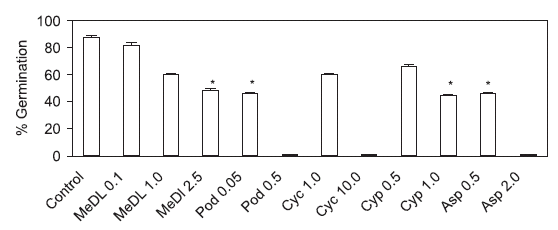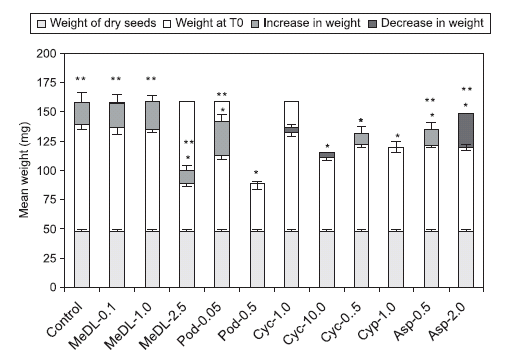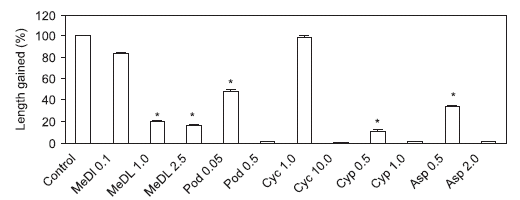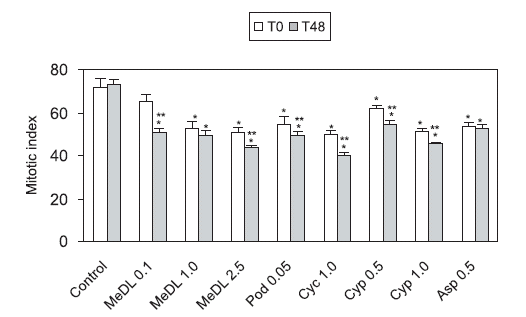Servicios Personalizados
Revista
Articulo
Indicadores
-
 Citado por SciELO
Citado por SciELO
Links relacionados
-
 Similares en
SciELO
Similares en
SciELO  uBio
uBio
Compartir
Biocell
versión impresa ISSN 0327-9545
Biocell v.33 n.1 Mendoza ene./abr. 2009
Germinating seeds of the mung bean, Vigna radiata (Fabaceae), as a model for the preliminary evaluation of cytotoxic effects of drugs
Vijay L. Kumar*, Abhishek Singhal
Department of Pharmacology, All India Institute of Medical Sciences, Ansari Nagar, New Delhi 110 029, India
Address correspondence to: Vijay L. Kumar. Department of Pharmacology, All India Institute of Medical Sciences, Ansari Nagar, New Delhi 110 029, INDIA. E-mail: kumarvl98@hotmail.com ; kumarvl98@gmail.com
ABSTRACT: Cytotoxic properties of plant extracts and drugs being developed for cancer treatment are usually evaluated by a variety of in vivo and in vitro tests carried out in animal or plant based models. In the present study we have evaluated the possibility of using the germinating mung beans (Vigna radiata), for rapid and inexpensive screening of drugs exhibiting cytotoxic properties. Mung beans were allowed to germinate either in tap water or in different drug solutions, and parameters like percent germination, increase in radicle length, change in seedling weight and mitotic index of apical root meristems were determined at two time intervals coinciding with the time at which the radicle length in control group was 1.0 to 1.5 cm (time 0, T0) and 48 h later (T48). Methanol extract of Calotropis procera latex as well as drugs like podophyllotoxin, cyclophosphamide, cyproheptadine and aspirin produced a dose-dependent inhibitory effect on seed germination, seed weight gain, radicle growth and mitotic index in the radicle meristems. The inhibitory effect of some of the drugs tested was associated with reduction in water imbibition. Some of the drugs at higher concentrations allowed seed germination to take place but produced radicle decay and seedling weight loss. Our study shows that germinating V. radiata beans could be used as a convenient model for the preliminary screening of drugs exhibiting cytotoxic properties.
Key words: Phaseolus aureus; Calotropis procera; Podophyllotoxin; Cyclophosphamide; Aspirin
Introduction
A number of drugs and plant extracts exhibiting cytotoxic properties are either used or intended to be used for the treatment of various cancers. These drugs interfere with cell-cycle kinetics and inhibit the proliferation of mitotically active cells either by damaging the DNA during S-phase of the cell cycle or by blocking the formation of mitotic spindle in the M phase (Gali-Muhtasib and Bakkar, 2002). Cyclophosphamide, a DNA alkylating agent, exhibits antimitotic activity both in vivo and in vitro (Crook et al., 1986; Misra and Bloom, 1991; Gereis et al., 1987). On the other hand, several other plant derived anticancer drugs affect microtubule dynamics and signaling pathways that ultimately lead to mitotic arrest or apoptotic cell death (Mollinedo and Gajate, 2003). Besides that, it has also been established through various experimental and clinical studies that non steroidal drugs possessing anti-inflammatory activity (NSAIDs), as well as the latex of the milkweed, Calotropis procera (Aiton) (Asclepiadaceae), may also exhibit anticancer properties (Umar et al., 2003; Choedon et al., 2006).
Despite the current availability of a multiplicity of anticancer agents, there is a continuous search for new compounds that may be more effective and safe. Various experimental models that are commonly used for the evaluation of anticancer and cytotoxic compounds are based either on in vivo studies that include xenografts in nude mice, carcinogen induced tumors in rodents, transgenic and knockout mice or on in vitro studies on tumor cell lines (Teicher, 2002). However, there is greater emphasis on in vitro studies for the initial screening that is followed by validation in an animal model. A simple model that has been widely used for such stud-ies is the root tip meristem of Allium cepa, a tissue of actively dividing cells (Sharma, 1983). However, due to chemical treatment of the bulbs for long term storage, this model poses problems in growing root tip meristems. The present study was therefore carried out to evaluate the response of germinating mung beans, Vigna radiata (L.) (Fabaceae), to several drugs and plant extracts with the aim of developing a rapid and inexpensive cytotoxicity test for the preliminary screening of new drugs.
Materials and Methods
Testing conditions
Mung beans (weighing 47.82 ± 1.50 mg) used in this study were obtained from the local market. They were soaked in tap water in the control group or in a drug solution in the test group for 6 h. The water or the drug solution was drained and the seedlings were kept moist (either with tap water or the drug solutions in a covered Petri dish) until the radicles in the control group had grown to 1.0-1.5 cm (time 0, T0). At T0, the weight of seedlings, % germination, length of radicle and mitotic index were recorded both in the control and test groups. The seedlings were maintained at room tem-perature under moist conditions for an additional period of 48 h (T48). All the parameters recorded at T0 were again measured at T48. The change in weight and gain in radicle length between T0 and T48 were calculated. The seeds that did not germinate were simply weighed and no other parameters could be measured on these seeds.
Plant extract and drugs tested
The latex was collected from the aerial parts of the milkweed, (Calotropis procera (Aiton), Asclepiadaceae) growing in Delhi. The plants were identified by the Raw Materials, Herbarium and Museum Division, National Institute of Science Communication, CSIR, New Delhi and a voucher specimen of the plants used in the current investigation was deposited at this Division of CSIR (Voucher No. PID 1739). The latex was air dried in a shaded room and its methanol extract was prepared according to Arya and Kumar (2005). Other drugs included in the study were podophyllotoxin, cyclophosphamide, cyproheptadine and aspirin.
Working dilutions of all drugs were made in tap water. The latex extract was ground in water to obtain 0.1 mg/mL, 1.0 mg/mL and 2.5 mg/mL concentrations. Podophyllotoxin, a plant toxin used topically for the treatment of genital lesions caused by virus (genital warts), was first dissolved in 100 μl ethanol and then diluted to the required concentrations (0.05 mg/mL and 0.5 mg/mL) in tap water. Cyclophosphamide, a DNA alkylating drug, was used at 1.0 mg/mL and 10.0 mg/ mL concentrations. Cyproheptadine, a histamine and serotonin antagonist, was used at 0.5 mg/mL and 1.0 mg/mL concentrations, while aspirin, a non-steroidal anti-inflammatory drug, was used at 0.5 mg/mL and 2.0 mg/mL concentrations.
Determination of mitotic index
The tips of the radicles (2-3 mm) were collected from the germinating seedlings at T0 and T48 and were placed in 1 N HCl for 5 minutes, squashed and stained with 2% aceto-orceine. In each radicle tip the mitotic and total cells were counted in 5-8 fields (400-500 cells) using light microscope (X100) (Badria et al., 2001). The mitotic index was calculated as the percent of meristem cells undergoing mitosis.
Statistical analysis
Results are expressed as mean ± SEM of 10-35 observations per group and ANOVA followed by a post hoc test (LSD) was used to compare groups. Differences between weight and mitotic index recorded at time T0 and T48 were evaluated by the Student's t test. In all cases, the level of statistical significance was fixed at P < 0.05.
Results
Eighty eight percent of mung beans germinated in the control group under the test conditions. Latex extract and other drugs included in this study produced a dose-dependent inhibitory effect on seed germination (Fig.1). At higher concentration podophyllotoxin, cyclophosphamide and aspirin completely inhibited seed germination while in the latex extract and cyproheptadine treated groups, the seed germination was 48 and 44% respectively (P < 0.05).

FIGURE 1. Effect of a methanol extract of latex of milkweed, Calotropis procera (MeDL), and of several drugs (podophyllotoxin, Pod; cyclophosphamide, Cyc; cyproheptadine, Cyp; aspirin, Asp) on the germination of mung beans, Vigna radiata. Concentrations are given as mg/mL. Stars indicate statistically significant differences (P<0.05) from the control group (ANOVA; the LSD test was used for post hoc comparisons with the control group).
The extent of water imbibition and seedling growth was indicated by an increase in seedling weight at T0 as compared to the weight of dry seeds (Fig. 2, open bars vs. dotted bars). All the treatment groups showed a dose-dependent inhibitory effect on the initial weight gain except cyproheptadine. The change in weight of seedlings between T0 and T48 is also shown in figure 2 where increase in mean weight is denoted as shaded bars and decrease in mean weight is denoted as black bars. There was a significant increase in seedling weight between T0 and T48 in the control group (p<0.05). It is interesting to note that podophyllotoxin, cyclophosphamide and aspirin produced a decrease in seedling weight between T0 and T48 at higher concentration. A decrease in seedling weight was also observed at lower concentration of cyclophosphamide. The treatment of seeds with higher concentration of the latex extract, both the concentrations of cyproheptadine and lower concentration of aspirin was associated with a marked inhibition in weight gain between two time intervals. At higher concentration of cyproheptadine where 44% seeds germinated, an initial growth of the radicle by time T0 was followed by complete inhibition of radicle growth in subsequent 48 h period.

FIGURE 2. Effect of different treatments on the weight of germinating seeds at time 0 (T0), time at which radicle length of seedling in control group reached 1.0 to 1.5 cm and 48 h later (T48). Treatment abbreviations and concentrations are as given in Fig. 1. Upward error bars represent SEM for T48 while downward error bars indicate SEM for T0 in case of increase in mean weight and vice versa in case of decrease in mean weight from the weight at T0. One star indicates a statistically significant difference between the mean weight in the treated group and the mean weight in the control group (ANOVA and LSD post hoc test; P < 0.05). Two stars indicate a statistically significant difference between weight at T0 and at T48 (Student's t test, P < 0.05). Dry weight of seeds (mean ± SEM) is indicated as a dotted bar.
The gain in radicle length at T48 was markedly affected by most of the treatments in a dose-dependent manner (Fig. 3). As a consequence of total suppression of germination, higher concentration of drugs like podophyllotoxin, cyclophosphamide and aspirin did not allow any growth of the seedling. The latex extract also produced a significant decrease in radicle growth at the two higher concentrations.It is interesting to note that drugs like podophyllotoxin, cyclophosphamide and aspirin also produced radicle decay.

FIGURE 3. Effect of different treatments on radicle length gained between time 0 (T0) and time 48 (T48). Results are expressed as percent increase with respect to the control group. A star indicates a statistically significant difference from the control group (ANOVA and LSD post hoc test; P < 0.05).
The mitotic index was determined in the meristem cells of radicle tips collected at both the time intervals i.e., T0 and T48 and it was found to be similar. Latex extract produced a significant decrease in the mitotic index that was dependent both on the concentration and time of exposure (T0 and T48). Similarly, all other drugs produced a significant decrease in mitotic index at concentrations where radicles appeared though their growth was retarded (Fig. 4).

FIGURE 4. Effect of different treatments on mitotic index of radicle tip meristem cells at time 0 (T0) and time 48 (T48). One star indicates a statistically significant difference in the mean value in the treated group from the control group (ANOVA and LSD post hoc test; P < 0.05). Two stars indicate a significant difference between T0 and T48 of the same treatment.
Discussion
There is a growing need to develop simple in vitro methods for the preliminary screening of putative anticancer drugs that could be followed by validation in animal model (Teicher, 2002). In the present study we have evaluated the response of germinating mung beans, Vigna radiata (syn. Phaseolus aureus) to several drugs and plant extracts.
Growth of quiescent embryo in the seed begins as a consequence of a triphasic process of water imbibition in the seeds that finally brings about shedding of seed coat and radicle emergence (protrusion). In fact, water imbibition in seeds is associated with the transi-tion from the metabolically inactive quiescent stage to the rapidly dividing stage where cells in G1 phase shift to G2 phase that precedes cell division and subsequent growth of the radicle (Bradford, 1990; de Castro et al., 2000). Reduction in seed germination in the present study was always associated with a reduction in weight gain at time 0. It is possible that some of the drug treat-ments may have affected water and osmotic potential thus preventing the development of turgor pressure in the seed, which has been considered as one of the key factors for the initiation of radicle growth during seed germination (Maia and Rainer, 2001).
Water imbibition was allowed to some extent by the latex extract, cyproheptadine and low concentrations of podophyllotoxin, cyclophosphamide and aspirin while higher concentrations of these drugs completely inhibited weight gain. Reduction in water imbibition brought about by these drugs failed to trigger seed germination. Further, soaking the seedlings in higher drug concentrations not only produced a growth retarding effect, but it also produced radicle decay as seen with podophyllotoxin, cyclophosphamide and aspirin. The growth retardation with these drugs could have also resulted from the inhibition of cell division and radicle protrusion brought about by osmotic stress (de Castro et al., 2000).
In present study the growth retardation brought about by drugs was found to be associated with a significant reduction in mitotic index in the root tip meristematic tissue. Like the methanol extract of dried latex, the crude dried latex of C. procera has earlier been shown to exhibit antimitotic activity in the Allium cepa model (Sehgal et al., 2006). As expected, podophyllotoxin, a plant derived toxin which acts by interfering with microtubule assembly (Jordan, 2002) produced a decrease in the mitotic index. Drugs like cyclophosphamide, cyproheptadine and aspirin that may lead to cell cycle arrest and apoptosis in vitro (Schwartz and Waxman, 2001; Zang et al., 1975; Bellosillo et al., 1998) also produced different degrees of inhibition of germination, radicle growth, and mitotic activity in the radicle of germinating mung beans.
Based on the results of present study, it could be concluded that the germinating mung beans could be used for the rapid and inexpensive screening for the cytotoxic effects of new drugs.
References
1. Arya S, Kumar VL (2005). Antiinflammatory efficacy of extracts of latex of Calotropis procera against different mediators of inflammation. Mediators of Inflammation 2005: 228-232. [ Links ]
2. Badria FA, Houssein WE, Zaghloul MG, Halim AF (2001). Antimitotic activity of gossypol and gossypolone. Pharmaceutical Biology 39: 120-126. [ Links ]
3. Bradford KJ (1990). A water relations analysis of seed germination rates. Plant Physiology 94: 840-849. [ Links ]
4. Bellosillo B, Pique M, Barragan M, Castano E, Villamor N, Colomer D, Montserrat E, Pons G, Gil J (2001). Aspirin and salicylate induce apoptosis and activation of caspases in B-cell chronic lymphocytic leukemia cells. Blood 92: 1406-1414. [ Links ]
5. Choedon T, Mathan G, Arya S, Kumar VL, Kumar V (2006). Anticancer and cytotoxic properties of the latex of Calotropis procera in a transgenic mouse model of hepatocellular carcinoma. World Journal of Gastroenterology 12: 2517-22. [ Links ]
6. Crook TR, Souhami RL, McLean AE (1986). Cytotoxicity, DNA cross-linking and single strand breaks induced by activated cyclophosphamide and acrolein in human leukemia cells. Cancer Research 46: 5029-5034. [ Links ]
7. de Castro RD, Lammeren AM, Groot SPC, Bino RJ, Hilhorst WM (2000). Cell division and subsequent radicle protrusion in tomato seeds are inhibited by osmotic stress but DNA synthesis and formation of microtubular cytoskeleton are not. Plant Physiology 122: 327-336. [ Links ]
8. Gali-Muhtasib H, Bakkar N (2002). Modulating cell cycle: current applications and prospects for future drug development. Current Cancer Drug Targets 2: 309-336. [ Links ]
9. Gereis M, Burford-Mason A P, Watkins SM (1987). Suppression of in vitro peripheral blood lymphocyte mitogenesis by cytotoxic drugs commonly used in the treatment of breast cancer. Agents Action 22: 324-329. [ Links ]
10. Jordan MA (2002). Mechanism of action of antitumor drugs that interact with microtubules and tubulin. Current Medicinal Chemistry. Anti-Cancer Agents 2: 1-17. [ Links ]
11. Maia A, Rainer L (2001). Changes in water relations, solute leakage and growth characters during seed germination and seedling development in Trigonella coerulea (Fabaceae). Jounal of Applied Botany 75: 144-151. [ Links ]
12. Misra RR, Bloom SE (1991). Roles of dosage, pharmacokinetics and cellular sensitivity to damage in the selective toxicity of cyclophosphamide towards B and T cells in development. Toxicology 66: 239-256. [ Links ]
13. Mollinedo F, Gajate C (2003). Microtubules, microtubule interfering agents and apoptosis. Apoptosis 8: 413-450. [ Links ]
14. Schwartz PS, Waxman DJ (2001). Cyclophosphamide induces caspase 9-dependent apoptosis in 9L tumor cells. Molecular Pharmacology 60: 1268-1279. [ Links ]
15. Sehgal R, Roy S, Kumar VL (2006). Evaluation of cytotoxic potential of latex of Calotropis procera and podophyllotoxin in Allium cepa root model. Biocell 30: 9-13. [ Links ]
16. Sharma CBSR (1983). Plant meristems as monitors of genetic toxicity of environmental chemicals. Current Science 52: 1000-1002. [ Links ]
17. Teicher BA (2002). Tumor models in cancer research. Humana press. New Jersey. [ Links ]
18. Umar A, Viner JL, Anderson WF, Hawk E (2003). Development of COX inhibitors in cancer prevention and therapy. American Journal of Clinical Oncology 26: S48-57. [ Links ]
19. Zang KD, Eicke J, Stengel-Rutkowski S, Zankl H (1975). Chromosome studies on human fibroblast cultures following exposure to cyproheptadine. Zeitschrift fur Kinderheilkunde 118: 303-313. [ Links ]
Received: October 24, 2007.
Final version received: December 19, 2008.
Accepted: December 20, 2008














